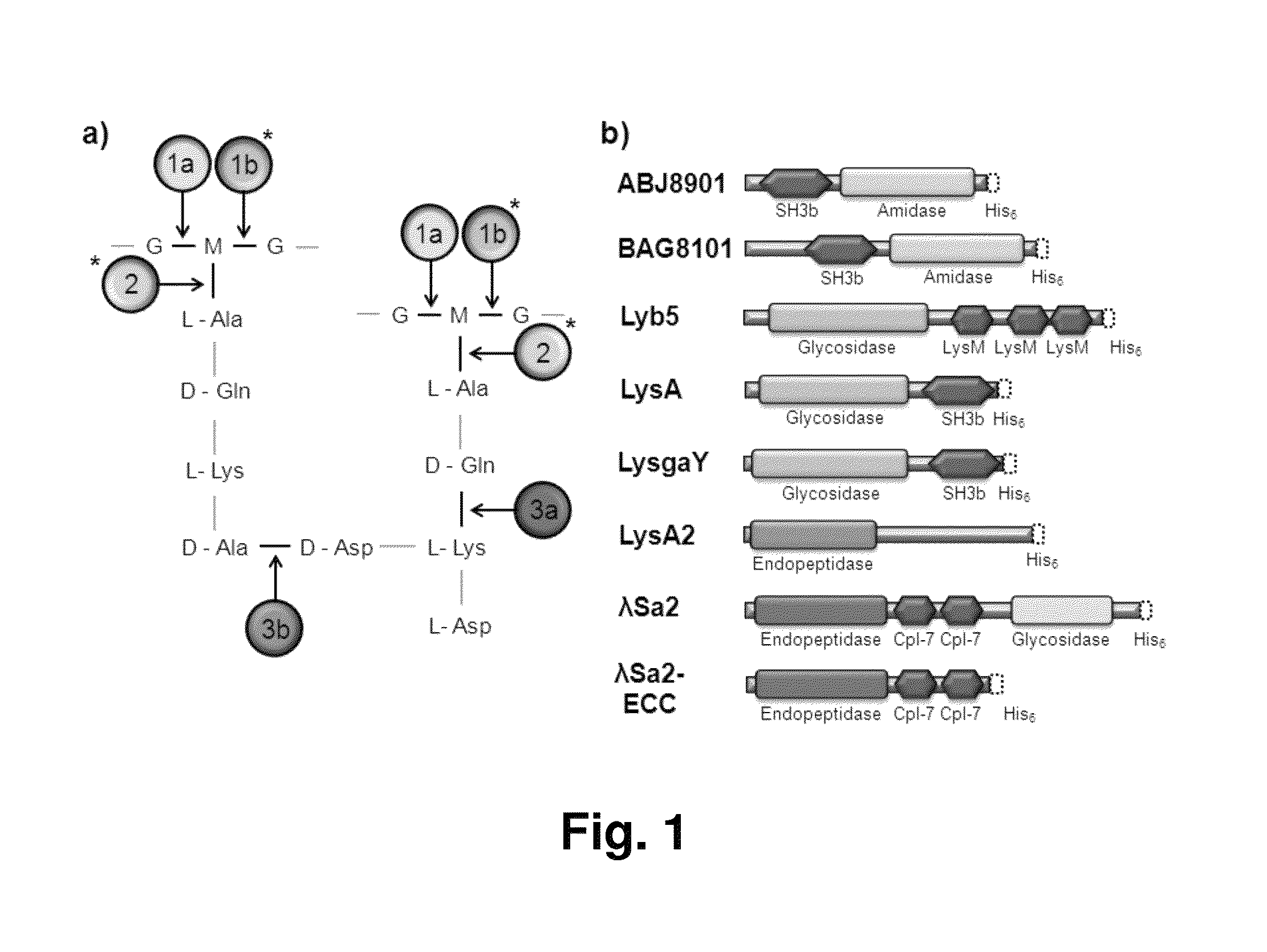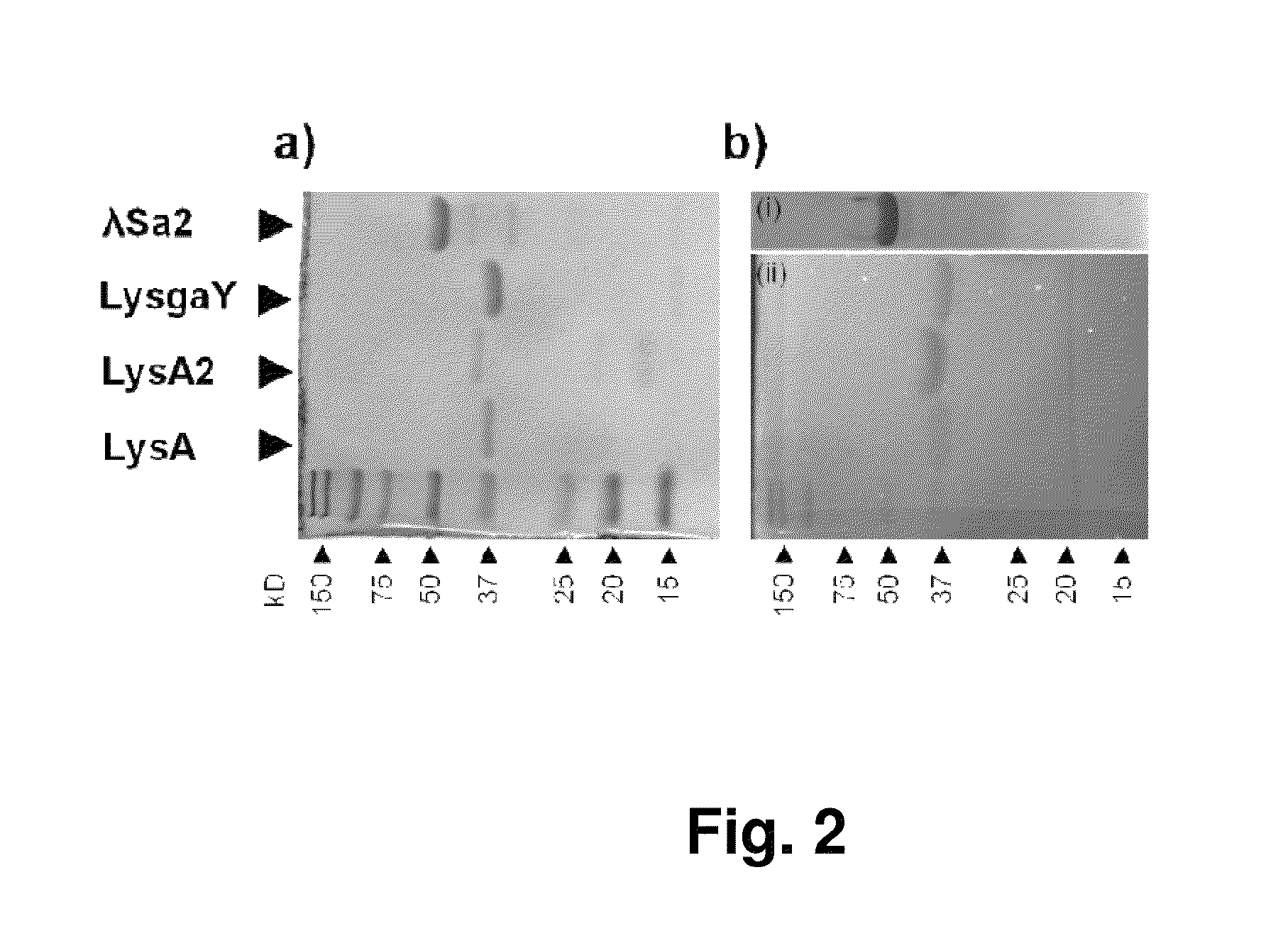Peptidoglycan hydrolase antimicrobials for eradicating lactobacilli that contaminate and reduce ethanol yields in biofuel fermentation
a technology of lactic acid bacteria and peptidoglycan hydrolase, which is applied in the field of peptidoglycan hydrolase antimicrobials for eradicating lactobacilli, can solve the problems of ethanol loss, lactic acid bacteria are the most detrimental, and the economics of biofuel production is weakening
- Summary
- Abstract
- Description
- Claims
- Application Information
AI Technical Summary
Benefits of technology
Problems solved by technology
Method used
Image
Examples
example 1
Constructs, Strains, and Plasmids
[0066]The lysins that were bioinformatically selected and synthesized or obtained for use in this study are listed in Table 1. LysA, LysA2, LysgaY genes were bioinformatically reverse translated with an E. coli codon bias and gene nucleotide sequences were commercially synthesized and cloned into pUC57 vector (GenScript, Piscataway, N.J.). The Streptococcus agalactiae phage lysin λSa2 (EMD Biosciences, San Diego, Calif.) was obtained as a gift from Pritchard et al., supra. LysA, LysA2, LysgaY genes were subcloned into the pET21a E. coli expression vector (EMD Biosciences, San Diego, Calif.), which adds an XhoI restriction enzyme site and 6×His codons at the 3′ end of the coding sequences (resulting in LEHHHHHH added to the N-terminus of the native protein). The plasmids were maintained in E. coli DH5α (Invitrogen, Carlsbad, Calif.) at 37° C. in LB medium supplemented with 150 μg / ml ampicillin for plasmid purification, maintenance and DNA sequence ver...
example 2
Expression and Purification of Lysins
[0070]All lysin proteins were over-expressed in E. coli and purified via nickel column chromatography as previously described (Becker et al. 2009. Gene 443:32-41). Purified pET21a harboring the lysin genes of interest, were transformed into E. coli BL21(DE3) (Invitrogen, Carlsbad, Calif.) by heat shock at 42° C. for 30 s. BL21(DE3) transformants were cultured at 37° C. in 1 L modified LB (mLB) medium (15 g / l tryptone, 8 g / l yeast extract, 5 g / l NaCl) supplemented with 150 μg / ml ampicillin. Mid log phase (OD600 nm of 0.4-0.6) cultures were induced with 1 mM IPTG (isopropyl-beta-D-thiogalactopyranoside), followed by 10° C. overnight incubation. Induced cells were pelleted, resuspended in 10 mL of lysis buffer (50 mM NaH2PO4, 300 mM NaCl, 10 mM imidazole, 30% glycerol, pH 8.0), and sonicated on ice for 15 min (1 s pulses separated by 1 s rests). After centrifugation (9000×g for 30 min), proteins were purified from the cleared supernatant by immobili...
example 3
Zymogram and Turbidity Reduction Assays
[0073]The purified proteins and Kaleidoscope protein standards (Bio-Rad) were analyzed using 15% SDS-PAGE, with or without 300 mL equivalent of mid log phase (OD600 nm of 0.4-0.6) lactobacilli cells that were pelleted, and washed twice in buffer (50 mM NaH2PO4, 150 mM NaCl, pH 8.0) prior to addition to the pre-polymerized gel. Gels were electrophoresed at 150 volts (˜1 h). SDS-PAGE gels were Coomassie stained and zymograms were washed in excess H2O for 1 h and incubated at 24° C. in 50 mM Tris-HCl, 1% Triton X114, pH 5.5, until visible translucent bands appeared and images taken (˜18 h).
[0074]The turbidity assays were performed in a Molecular Devices Spectra Max 340 plate reader. Strains were grown to mid-log phase (OD600 nm=0.4-0.6) at 37° C., washed in buffer (20 mM phosphate, 150 mM NaCl, 30% glycerol: pH 8.0), pelleted, and frozen at ˜80° C. Cells were thawed on ice and resuspended to OD600 nm=2.0 in buffer (20 mM phosphate, 150 mM NaCl: pH...
PUM
| Property | Measurement | Unit |
|---|---|---|
| intracellular pressure | aaaaa | aaaaa |
| intracellular pressure | aaaaa | aaaaa |
| concentrations | aaaaa | aaaaa |
Abstract
Description
Claims
Application Information
 Login to View More
Login to View More - R&D
- Intellectual Property
- Life Sciences
- Materials
- Tech Scout
- Unparalleled Data Quality
- Higher Quality Content
- 60% Fewer Hallucinations
Browse by: Latest US Patents, China's latest patents, Technical Efficacy Thesaurus, Application Domain, Technology Topic, Popular Technical Reports.
© 2025 PatSnap. All rights reserved.Legal|Privacy policy|Modern Slavery Act Transparency Statement|Sitemap|About US| Contact US: help@patsnap.com



